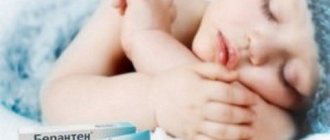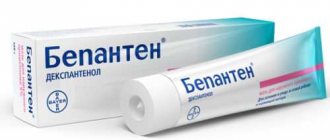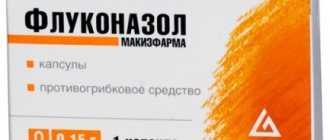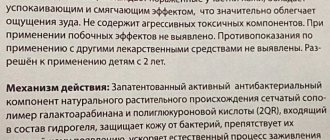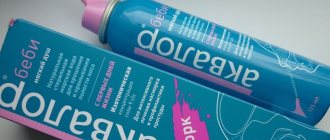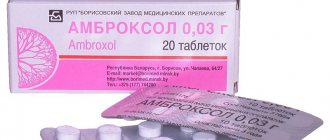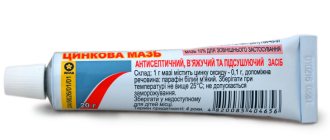Would you like to have a universal cream in your medicine cabinet that can be used not only for newborn babies, but also for their mothers during breastfeeding, and in a number of other situations? Then you should take a closer look at the Bepanten line. There are drugs, as they say, for all occasions. And Bepanten can be classified as such a remedy.
What is good about Bepanthen for nursing mothers? What active ingredient makes it safe yet effective? And what is the difference between ointment and cream? Let's figure it out.
Bepanten: composition
Whatever form of bepanthen you choose, the active component will be the same: dexpanthenol. Penetrating perfectly through the skin, dexpanthenol is converted into pantothenic acid (another name is vitamin B5), and then into pantethine, which is part of coenzyme A. Thus, having gone through a chain of transformations, pantothenic acid participates in the processes of oxidation, metabolism of fats, proteins and carbohydrates, and also has good regenerative properties on the mucous membranes and skin.
It turns out that bepanten is a vitamin cream or ointment (depending on what you choose), absolutely safe for both newborns and nursing mothers.
Effect of Bepanten cream
The product is easily applied to the skin, quickly absorbed, beginning its active transformation, thereby replenishing pantothenic acid reserves. The drug acts in the following directions:
- stimulates tissue regeneration;
- participates in carbohydrate and fat metabolism;
- normalizes cellular metabolism;
- increases the strength of collagen fibers;
- has an anti-inflammatory effect;
- moisturizes irritated and dry skin.
Bepanten gently cares for sensitive skin and has wound-healing properties. Replenishes the amount of pantothenic acid on damaged skin or mucous membranes.
Read more What is Triacutan ointment used for: instructions and analogues
Application area
The first experience of putting a baby to the breast can be quite uncomfortable. During this period, the mammary glands require special care and careful treatment of them, because problems associated with lactostasis or cracked nipples cause pain and reluctance to feed. And if lactostasis is dealt with by frequently latching the baby and massaging the breasts, then for cracks a safe wound healing agent is needed.
So, the instructions for Bepanten indicate that it is used for:
- preventive treatment of dry skin;
- skin treatments for newborns (prevention and treatment of diaper dermatitis);
- skin care during the cold season;
- for microcracks or irritation in the nipple area in women who are breastfeeding;
- for anal fissures, scratches, skin ulcers, burns;
- for healing cervical erosion;
- treatment of the skin after topical application of corticosteroids.
Bepanten is suitable for the treatment of cracked nipples in nursing mothers
The purpose of the medicinal and cosmetic product Bepanten is to moisturize the skin and heal wounds. Bepanten does not contain dyes, preservatives or parabens, therefore it is recognized as one of the best products for mothers and their babies.
Since Bepanthen restores epidermal cells not only on the surface, but also deep inside, it is also used after childbirth for stretch marks.
How to use?
It is recommended to lubricate the breasts of a nursing mother with Bepanten every time after feeding . And also twice a day to prevent cracks.
There is no need to wash off the product before applying the baby. In 99% of cases, the ointment is completely absorbed into the skin and does not leave any traces. However, even if a little of the product remains, it will not cause any harm to the baby. The only problem may be that the baby refuses to breastfeed due to the aftertaste of the ointment, but this also happens very rarely. Usually everything goes “smoothly”.
In cases where the cracks have already become deep and have begun to bleed, you need to lubricate the mammary glands with a thin layer immediately before applying the baby. The course of epidermal restoration takes about seven to ten days . But for complete healing and prevention of re-cracking, we recommend extending this course, but reducing the frequency of application.
ATTENTION! Most young mothers, having listened to the advice of the older female generation of the family, begin to treat the nipples and the skin around them with soap before each feeding.
However, this is fraught with negative consequences: the skin becomes dry, begins to crack, and mothers get the result that they so vainly wanted to avoid.
The drug will also be useful for the baby . In case of diaper rash, rash, irritation or heat rash on his skin. The method of application is the same:
- Apply to damaged areas.
- Rub in with massage movements.
Relief will come after the first lubrication.
If your nipples do not suffer during feeding, then Bepanten should still be in your first aid kit . It will help moisturize the skin, thereby saving it from stretch marks, and the young mother from an unattractive appearance. Start applying the ointment immediately after you learn about the “interesting situation.” After all, the skin must be nourished before the volume begins to grow.
Bepanten is also one of the few remedies that can be used during pregnancy and from the first days of life to heal burns, abrasions, and cracks.
This drug is ideal after an episiotomy procedure . It will quickly restore the skin and reduce pain.
During childbirth, all the muscles of a young mother are strained to the limit, so often after childbirth, mothers observe hemorrhoidal fissures. Bepanten is also used for healing.
Why do cracked nipples occur?
According to some data, every fifth woman knows firsthand what sores on the nipples are during the lactation period. Why do they arise?
We recommend reading: Lactamil for nursing mothers
- Incorrect attachment to the breast. At the beginning of feeding, the baby does not yet have teeth, but if the baby does not fully grasp the nipple, along with the areola, there is a high probability of damage to it, and the baby will often swallow air. You can read about the breastfeeding technique here.
- Vitamin deficiency in the body. A weakened body after childbirth, irregular nutrition, and, moreover, deprivation of certain foods (mothers often go on a “diet” for the first time) suppress the immune system and lead to visible problems. For example, a lack of vitamin B5 affects the condition of the skin: it becomes dry and irritated at the slightest friction.
- Incorrectly chosen bra. It is no secret that after the birth of a child, breasts increase in size, and therefore the bra should become 1-2 sizes larger. Otherwise, regular rubbing of the nipples will result in injury.
- Lack of hygiene. Here you need to find a middle ground. On the one hand, infrequent nipple washing leads to the spread of infection, since leaking milk in a warm place is a good substrate for bacterial growth. On the other hand, excessive love for cleanliness contributes to dry skin, and friction with a towel irritates the skin and can damage it.
- Chronic diseases of the mother. Some diseases, such as diabetes, lead to the formation of cracks. The problem is treated by applying bepanthen and adjusting the diet. The doctor can give specific recommendations depending on the disease causing the cracks.
- Inappropriate use of a breast pump. Unless absolutely necessary, use the breast pump as little as possible. Remember, only your baby can develop the best breast development.
The illustration clearly demonstrates the correct grasp of the nipple by the baby along with the areola, on which successful feeding depends
Use of Bepanten cream for nursing mothers and infants
Latin name: Bepanthen ATC code: D03AX03 Active ingredient: dexpanthenol Manufacturer: Bayer, Germany Condition of release from the pharmacy: Without a prescription
The period while in the maternity hospital and two to three months after it is the most difficult for mothers.
At this time, a restructuring of the body occurs, the woman puts the baby to her breast. About 40% of young mothers experience difficulties during lactation. The nipples become covered with cracks, and pain occurs with each feeding. To eliminate discomfort, you can consult a doctor. A specialist will always tell you which drug will help solve the problem.
One of the most effective remedies is Bepanten in the form of an ointment or cream.
Indications
Cracked nipples are a common occurrence, especially among new mothers who are new to breastfeeding. Damage occurs after initial attempts, while still in the maternity hospital. Bepanten is recommended for use in the following cases:
- Incorrect attachment of the baby, as a result of which the baby grasps the breast incorrectly with his mouth
- Insufficient breast hygiene
- Pathogenic viruses getting into cracks
- Lack of skills in using a breast pump
- Careless and sudden removal of the nipple from the child’s mouth.
Compound
Mothers often ask specialists whether they need to wash off the cream before feeding. This is important, because not every woman knows how dangerous the situation is if the baby has eaten some part of the ointment.
To understand this issue, you can find out the properties of the components that make up Bepanten, since it is recommended to purchase it in advance and take it with you to the maternity hospital:
Cream:
- Dexpanthenol is the main active ingredient.
- Synthesized pantothenic acid, which is a mixture of 12 vitamins.
- Ethylene glycol monophenyl ether. At a concentration of less than 1% it is absolutely safe and is used as an antimicrobial element and preservative.
- Phosphate cetyl potassium is an antioxidant.
- Natural wax - lanolin to soften the skin.
- Isopropyl myristate is a substance that smoothes the epidermis and can serve as a dermatological agent.
- Glycolic propylene is a dispersant to maintain the consistency of the cream.
- Ethal and stearyl are fatty alcohols as solvents.
- Purified water.
Ointment:
- Dexpanthenol is the main active ingredient.
- Variable protegin mixture for preparing a paste composition.
- Beeswax and paraffin as softeners.
- Almond oil with nourishing and protective properties.
- Fatty alcohol compounds.
All components are absolutely safe and cannot harm the mother when used from the first days in the maternity hospital. In addition, there is no need to worry if the child eats a small part.
When it gets into the mouth, Bepanten is practically not noticeable, since it has no taste, so you can leave it before breastfeeding or wash it off - it depends only on the desire of the mother.
Medicinal properties
When applied to the skin, Bepanten, when absorbed, releases acid, which is the main factor in the restoration processes. The substance belongs to coenzymes that stimulate regeneration and accelerate metabolic reactions. In the process of treating cracked nipples, a breastfeeding mother is provided with the following effects:
- Rapid healing of open wounds
- Skin softening
- Nipple healing
- Elimination of pain syndrome
- Tissue repair
- Prevention of cracking and dryness from the first days in the hospital
- Prevention of breast stretch marks
- Preventing thrush in a child.
Both forms are suitable for mothers - ointment and cream, so you can take any of them. The difference is only in fat content, the first option copes well with the healing of cracked nipples, the second – with dry skin.
Bepanten is instantly absorbed and combines with protein albumin and globumin in the plasma. The resulting acidic pantothene does not participate in the body's metabolic processes and is excreted unchanged.
Release form
Bepanten is available in the form of an ointment or cream of 5% light, almost white, packaged in aluminum alloy tubes with a polypropylene cap and protective film.
The cap is equipped with a perforated tip for opening the membrane. The cardboard box is white and blue, the tube has a similar color. The package includes one piece and instructions.
The product is odorless and tasteless. Container volume – 30 and 100 gm.
Directions for use for nursing mothers
Bepanten should be applied to the mammary glands after each lactation process for deep cracks in the nipples, and twice a day as a preventative measure.
There is no need to wash off the drug before applying to the baby. The drug is absorbed almost completely, but if some part gets into the newborn’s mouth, there is no need to worry, since the drug is harmless. Usually the baby takes the breast with the applied composition without problems.
If the cracks are deep and bleed, it is recommended to apply Bepanten in a thin layer before feeding and not rinse off. This will help make the lactation process more comfortable. Treatment is carried out for 7-10 days, but as a preventive measure the course can be extended.
Many mothers prefer to treat their nipples with soap, but excessive hygiene can be bad for the skin. Cosmetics dry out the epidermis too much, which leads to pain and worsening of the cracks. Therefore, it is not recommended to wash off the protective layer of Bepanten from the chest.
The drug is also useful for eliminating diaper rash and rashes in the baby. Before changing the diaper, wash and dry the skin and apply a thin layer of cream. Improvement occurs after the first use.
In addition, the ointment copes well with other injuries: burns, scratches, abrasions, insect bites. It can be used from the first minutes of being in the maternity hospital and before that, during pregnancy.
If cracks in the juices do not bother you, the product is used as a preventive measure against stretch marks, which is important for all mothers without exception. You can smear regardless of feeding, but it is better to apply in the morning and evening before bed; there is no need to rinse off. For greater effect, it is recommended to treat the breasts starting from the first days in the maternity hospital.
Bepanthen is ideal after episiotomy. The sutures are treated two to three times a day, which helps to get rid of pain and speed up the regeneration and healing processes.
Many mothers develop hemorrhoidal fissures. The cream promotes rapid tissue tightening and restoration, which is why it is recommended to take it with you to the maternity hospital.
Contraindications
The only obstacle to the use of Bepantol is individual intolerance to the main active ingredient.
Compatibility with other medications
No negative or positive reactions were identified.
Adverse reactions
In some cases, when treating cracked nipples, redness and itching may occur. If the effects pass quickly, you must continue to smear the damaged areas. In case of prolonged manifestations, it is better to discontinue treatment before consulting a doctor.
Overdose
If the amount is exceeded, the excess can be removed with a cotton swab. This does not matter for the mother, but it is better not to allow a large layer to be applied so that the baby does not eat it when feeding.
Storage rules
Bepanten is suitable for use for 3 years. It should be kept in a dark place, away from children, at a temperature of 20-250C.
D-Panthenol
Stada Arzneimittel, Germany Cost: Cream 5% 25 mg – 250-270 rubles, 50 mg – 300-330 rubles, Ointment 5% 25 mg – 350-370 rubles, 50 mg – 400-430 rubles.
A drug with regenerating, metabolic and anti-inflammatory effects. Helps replenish pantothene deficiency, necessary for tissue restoration and healing.
The cream takes part in metabolic processes, synthesizes corticosteroids and porphyrins.
In addition, the components have a beneficial effect on peristalsis, which allows for easy use for the treatment of women during lactation.
Intended to eliminate dry skin, heal cracked nipples, and helps with diaper rash and dermatitis in children. Effective for rapid tissue regeneration after surgery.
The drug is creamy in color with a uniform consistency and a faint odor of lanolin, packaged in metal tubes. The three-color cardboard box includes 1 tube with a perforated tip on the lid and instructions.
Advantages:
- Can be used from the first days of being in the maternity hospital
- Quickly heals cracks, abrasions and burns.
Flaws:
- Contraindicated for allergic reactions
- Quite a high cost.
Pantoderm
Akrikhin KhFK, Russia Cost: Ointment 55 30 gm – 230-250 rub.
Preparation for external use. It has regenerating and anti-inflammatory properties. When absorbed into the blood, it releases pantothenic acid, which is involved in metabolic and regenerative processes.
As a result of the chemical reaction, collagen fibers are strengthened, cellular metabolism is normalized, and mucous membranes are regenerated.
Thanks to the removal of acyl residues into organic compounds, skin damage is eliminated very quickly and pain is reduced.
The product is prescribed for the treatment of cracked nipples, abrasions, scratches, and burns. Effective in eliminating diaper rash in babies, healing sutures, and preventing stretch marks. It is recommended to take it with you to the maternity hospital.
Pantoderm can be applied both after feeding and before it. There is no need to rinse off, as the product is quickly absorbed and does not harm the child if it gets into the mouth.
The ointment has a slightly yellow tint, a slight odor, is tasteless, and is packaged in aluminum tubes with a plastic cap and a protective membrane. The cardboard box is white, with yellow squares or a red and blue stroke in the center. Contains 1 tube and instructions.
Advantages:
- The drug reduces the feeling of discomfort when nipples are damaged during feeding
- Safe for children from the first days of life. No need to rinse off.
Flaws:
- May cause allergies if components are intolerant
- Rarely available in pharmacies.
Source: //lekhar.ru/lekarstva/dermatologicheskie-sredstva/bepanten-dlja-kormjashhih-mam/
Cream or ointment?
The concentration of the active component in the cream and ointment is the same - 5% dexpanthenol. The only difference is in texture and consistency, which differs due to the additional substances included in the product. The duration of the effect will depend on them.
The cream is more suitable for preventing cracks and dry skin. Its texture is soft, delicate, spreads well over the surface and is quickly absorbed without leaving behind a greasy residue. It is convenient to apply the cream immediately before going outside.
Even in the photograph it is noticeable that the texture of the cream, as well as its purpose, is different from the ointment. The difference is also obvious upon contact with skin.
The ointment is thicker, when it gets on the skin, it creates a protective sticky layer and penetrates deeply into the skin, having an effect longer than the cream. This is due to the content of natural lanolin in the ointment (250 mg, while the cream contains only 13 mg), which gives the skin the opportunity to breathe, while at the same time retaining moisture. Bepanten ointments are preferred specifically for the treatment of cracked nipples and diaper rash in infants. (Read about how to use Bepanthen in newborns here). The moisturizing effect in the ointment is also achieved through almond oil.
This is interesting. There is also a form of Bepanten Plus in the form of a cream and spray. In addition to dexpanthenol, the composition contains a mild antiseptic - chlorhexidine. It is used for scratches, abrasions, and wounds to disinfect the wound surface and heal it.
Analogs
Bepanten for cracks during feeding is prescribed only if the components of the product are well tolerated. If there are signs of allergic reactions to the composition of the ointment, it is recommended to consult a doctor for possible prescription of an analogue.
Possible substitutes:
- D-panthenol. The medicine is a regenerating agent for external use based on dexpanthenol. The drug has a stimulating effect, helps cope with excessive dryness, eliminates cracks, and regenerates damaged skin cells. Prescribed for various injuries that cause disruption of the integrity of the skin. It is also used as part of complex therapy for the formation of inflammatory processes on the skin. The product can be used during breastfeeding as a caring and preventive agent that prevents the development of cracks and damage in the nipple area during breastfeeding. The composition is applied to the damaged area 2 to 4 times a day or after each feeding of the child. The duration of treatment depends on the lactation period and can vary from 1 to 2 months. The cost of a tube (50 g) is from 430 rubles.
- Dexpanthen. A topical agent used in the treatment of various superficial lesions of the skin. Prescribed as the main remedy to promote rapid healing of damaged tissues. It has a strong stimulating effect, restores epithelization processes, accelerates regeneration and cell renewal. The drug is effective in the treatment of bedsores, abrasions, insect bites, and chronic ulcers. The product is also used during breastfeeding to eliminate cracks in the nipple area. When breastfeeding, the composition is applied after each feeding. The product is rubbed in gently and distributed over the entire area, including the surrounding skin. The duration of treatment depends on the period of lactation. Cost – from 120 rubles.
- Pantoderm. A dermatotropic drug is a vitamin-like drug that exhibits regenerating properties. It has a pronounced reparative effect. The main substance is dexpanthenol. When interacting with the surface of the skin, the active component is well absorbed, while stimulating cellular metabolic processes. It is used for any damage accompanied by a violation of the integrity of the skin. Eliminates signs of diaper rash, dryness, promotes healing of damaged tissue. The medication is prescribed for bedsores, trophic ulcers, cuts, abrasions, and also as a means to prevent the development of cracks during breastfeeding. When breastfeeding, the composition is applied to the affected area each time after feeding. The course of treatment depends on the duration of lactation. The cost of packaging (30 g) is 213-234 rubles.
- Panthenol. Dermatotropic drug for local use, dispensed in the form of liniment - ointment or cream. The main substance is dexpanthenol, which promotes the healing of wound surfaces and stimulates the natural processes of epithelization of damaged tissues. Prescribed in the treatment of bedsores, abrasions, scratches, mechanical or other damage to the skin, accompanied by a violation of the integrity of the skin. Additionally, the product is used for the formation of cracks in the nipple area. In case of pathology, the ointment is applied after each breastfeeding throughout the entire period of breastfeeding. The active substance has high penetrating ability, which affects the speed and level of regenerative processes. The cost of a tube (50 g) is from 429 rubles.
- Dexpanthenol. The medication belongs to the group of dermatoprotective and anti-inflammatory drugs for external use. The active ingredient of the drug is dexpanthenol. Liniment is used in the treatment of holistic skin disorders, exhibiting reparative and regenerating properties. Thanks to the action of the active substance, natural regeneration processes are stimulated, which, in turn, leads to rapid healing of the damaged area and activation of the metabolic functions of the skin. The drug is effective in the treatment of burn conditions, abrasions, scratches, insect bites, as well as the formation of cracks around the nipples during breastfeeding. If there are cracks in the nipple area, the ointment is applied after each feeding of the baby. The duration of treatment is situational or according to the lactation period. Cost – from 150 to 540 rubles.
It is prohibited to independently replace Bepanten with other drugs similar in composition or effect. Only a specialist should prescribe an analogue for cracks during feeding, taking into account the tolerability of the components and the individual physiological characteristics of the nursing mother.
Is it possible not to wash off Bepanten before feeding?
Can. As we have already said, the substance dexpanthenol itself cannot cause any harm to the baby. But we still recommend giving your baby clean breasts for at least two reasons.
Let nothing overshadow the process of feeding our children, because then the closest connection arises between mother and child
- It is not a fact that the baby will like Bepanthen ointment or cream, and he will not demonstrate refusal to feed by being capricious and turning away.
- Residues of milk in a warm place (many women have milk leaks in the first months), and even fed with cream, become an ideal environment for the development of bacteria, and this is a danger not only for mothers (bacteria, entering through cracks in the nipples into the mammary gland, can provoke inflammatory process), but also for their children, increasing the chances of developing oral thrush.
How to treat cracked nipples with Bepanten
Before starting treatment, mothers are interested in how and when to apply the ointment, and whether Bepanten should be washed off before feeding. It all depends on the condition of the breast skin and the severity of the damage.
Treatment and prevention
To treat small cracks, apply a thin layer of ointment to the nipples and damaged skin around them after each feeding. Excess drug is removed with a clean cotton swab or gauze pad. For deeper bleeding fissures, it is allowed to apply a little product before feeding to reduce pain in the mother. Treatment can last from 7 to 10 days.
To prevent cracks from appearing, ointment or cream is used twice a day. In addition, for breast hygiene you need to choose products that do not dry out the skin.
Do I need to wash off Bepanten before feeding?
Since the ointment has not only a regenerating, but also a mild analgesic effect, the question is whether Bepanten should be washed off before feeding the baby. The manufacturer's instructions say that if used during lactation, the drug should be washed off. However, many doctors argue that the ointment can be left on, since the active agent is well absorbed, and the composition of the drug is harmless to the child even if swallowed.
However, it is worth observing certain safety measures:
- do not allow milk to leak and mix with the ointment, since such an environment is ideal for the growth of bacteria,
- monitor the child’s reaction, since some components of the ointment may have a laxative effect,
- remove excess ointment before feeding.
In this regard, it is up to the mother herself to decide whether Bepanten needs to be washed off before feeding the baby.
Side effects
There is none of them. In rare cases, complaints of allergic reactions have been recorded, but such a response is primarily associated with the individual characteristics of a particular organism. If a child suckles on a breast lubricated with bepanthen, a slight laxative effect is possible, nothing more.
So, there is fundamentally no big difference between cream and ointment. It can be assumed that they are interchangeable. The main thing is that the regenerating effect in both products has been time-tested, and when you buy Bepanthen at the pharmacy, you can be sure that the product will be useful for the whole family.
